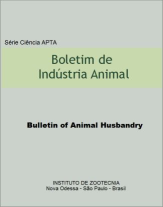Fermentation characteristics and chemical composition of tanzania grass silage containing additives
DOI:
https://doi.org/10.17523/bia.v73n3p189Keywords:
acidity, digestibility, effluents, ammoniacal nitrogen, pHAbstract
The objective of this study was to evaluate the fermentation characteristics and chemical composition of Tanzania grass silage containing additives. The following treatments were applied: silage without additive (SWA); silage treated with 2.17% limestones (SLS); silage treated with 2.17% urea (SUR), and silage treated with a combination of additives: 7.5% corn meal, 5.3% molasses powder, 1.1% urea and 1.1% limestone (SA1), and 10% corn meal, 2.93% molasses powder, 1.1% urea and 0.97% limestone (SA2). All silages containing additives exhibited a higher mean pH than SWA, but this did not negatively affect their fermentation quality. The titratable acidity of SWA (7.84) was higher than that of SUR (3.28), SLS (4.80), SA1 (3.30) and SA2 (3.80). The mean ammoniacal nitrogen was 10% lower in relation to total nitrogen in all silages, except for SUR, indicating a good fermentation profile. Effluent loss was lower for silages containing additives (P<0.005), with losses of 22.5, 12.1, 12.3 and 7.85 kg/t for SLS, SUR, SA1 and SA2, respectively, compared to SWA (46.1 kg/t). Dry matter content, total digestible nutrients and non-fibrous carbohydrates increased with inclusion of the additives, while neutral detergent fiber and hemicellulose content decreased. Dry matter digestibility was higher in SA1 and SA2 (45.8% and 44.4%, respectively) compared to the other silages, while SA2 did not differ from SWA (43.4%). The combination of chemical and organic additives had a positive synergistic effect to reduce effluent losses, neutral detergent fiber and acid detergent fiber and to increase dry matter digestibility, thus increasing nutrient availability. These silages therefore represent a good-quality final product.Downloads
Downloads
Published
Issue
Section
License
Os autores não serão remunerados pela publicação de trabalhos, pois devem abrir mão de seus direitos autorais em favor deste periódico. Por outro lado, os autores ficam autorizados a publicar seus artigos, simultaneamente, em repositórios da instituição de sua origem, desde que citada a fonte da publicação original seja Boletim de Indústria Animal. A revista se reserva o direito de efetuar, nos originais, alterações de ordem normativa, ortográfica e gramatical, com vistas a manter o padrão culto da língua e a credibilidade do veículo. Respeitará, no entanto, o estilo de escrever dos autores. Alterações, correções ou sugestões de ordem conceitual serão encaminhadas aos autores, quando necessário. Nesses casos, os artigos, depois de adequados, deverão ser submetidos a nova apreciação. As opiniões emitidas pelos autores dos artigos são de sua exclusiva responsabilidade. Todo o conteúdo deste periódico, exceto onde está identificado, está licenciado sob a Licença Creative Commons Attribution (CC-BY-NC). A condição BY implica que os licenciados podem copiar, distribuir, exibir e executar a obra e fazer trabalhos derivados com base em que só se dão o autor ou licenciante os créditos na forma especificada por estes. A cláusula NC significa que os licenciados podem copiar, distribuir, exibir e executar a obra e fazer trabalhos derivados com base apenas para fins não comerciais.













